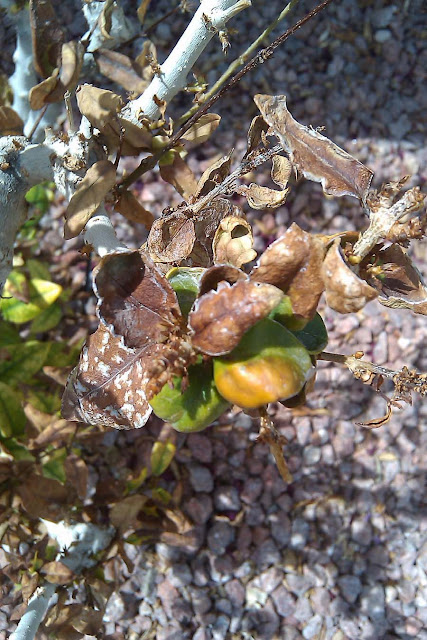Q. I cut back my roses last mid-winter and they grew back
just fine this summer. Later, all the leaves discolored, blotchy yellow. Any
advice how to correct this and prevent it from happening next year?
A. I would like to see some pictures showing me what you mean. But before I get into this, if you want roses in the desert I would go to the Rose Show on November 9. Rosarians are experts on growing roses in the desert. Some of them have 300 or 400 roses growing in their yards! They know roses. Come talk to them on November 9.
When it’s hot, the roses use more water. When
temperatures cool off, they need less water. If the soil stays soggy when
temperatures begin cooling, the newest leaves begin to yellow. It’s an iron
problem called chlorosis caused by suffocation of the roots.
temperatures cool off, they need less water. If the soil stays soggy when
temperatures begin cooling, the newest leaves begin to yellow. It’s an iron
problem called chlorosis caused by suffocation of the roots.
I have seen this too many times! Rock placed
on top of the soil contribute to a soil problem while woodchips won’t. Spraying
the plants with iron fertilizer may be a temporary fix but not a long term one.
on top of the soil contribute to a soil problem while woodchips won’t. Spraying
the plants with iron fertilizer may be a temporary fix but not a long term one.
 |
| Rocks covering the soil around roses eventually cause browning of leaves and dieback. |
Roses
like soils that allow water to drain from around the roots. To get this kind of
soil there must be organics in the soil. Organics come from things that rot,
not rock. Putting rock on top of the soil causes the soil to lose its organic
content over time. But the slow digestion or rotting of organics like woodchips
keeps the level of organics in the soil high over time.
like soils that allow water to drain from around the roots. To get this kind of
soil there must be organics in the soil. Organics come from things that rot,
not rock. Putting rock on top of the soil causes the soil to lose its organic
content over time. But the slow digestion or rotting of organics like woodchips
keeps the level of organics in the soil high over time.
 |
| Expect your roses to look like this in a couple of years if you use rock. |
The
rotting of organics is caused by moist soil, plant nutrients in the soil like
nitrogen, and warm soil temperatures. Rich compost has lots of plant nutrients
like nitrogen and organics all bundled together. This bundle of organics and
nutrients all rotting together helps keep a healthy balance of good chemistry that
benefit the plant nutritionally and environmentally.
rotting of organics is caused by moist soil, plant nutrients in the soil like
nitrogen, and warm soil temperatures. Rich compost has lots of plant nutrients
like nitrogen and organics all bundled together. This bundle of organics and
nutrients all rotting together helps keep a healthy balance of good chemistry that
benefit the plant nutritionally and environmentally.
 |
| Roses that grow this well will require compost and iron applications at a minimum. |
To
correct this yellowing problem requires some expense and work on your part.
When temperatures start to cool off this fall, remove whatever is covering the
surface of the soil. Mix iron chelate called EDDHA with some rich compost at a
rate of about 2 ounces per cubic foot of compost.
correct this yellowing problem requires some expense and work on your part.
When temperatures start to cool off this fall, remove whatever is covering the
surface of the soil. Mix iron chelate called EDDHA with some rich compost at a
rate of about 2 ounces per cubic foot of compost.
Auger
holes around the roses to about 12 inches deep and pour this compost and iron
mix in the holes and irrigate the plants. Replace the surface cover with
woodchips to a depth of 2 to 3 inches. Spray the leaves with a liquid iron
fertilizer three times, three to four days apart.
holes around the roses to about 12 inches deep and pour this compost and iron
mix in the holes and irrigate the plants. Replace the surface cover with
woodchips to a depth of 2 to 3 inches. Spray the leaves with a liquid iron
fertilizer three times, three to four days apart.
In the
early spring each year mix one ounce of EDDHA iron chelate in a bucket of water
and pour it around your roses along with your favorite rose fertilizer. This
should prevent leaf yellowing of roses in the future.
early spring each year mix one ounce of EDDHA iron chelate in a bucket of water
and pour it around your roses along with your favorite rose fertilizer. This
should prevent leaf yellowing of roses in the future.

